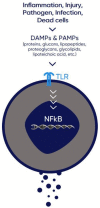Insights into CD24 and Exosome Physiology and Potential Role in View of Recent Advances in COVID-19 Therapeutics: A Narrative Review
- PMID: 36294907
- PMCID: PMC9604962
- DOI: 10.3390/life12101472
Insights into CD24 and Exosome Physiology and Potential Role in View of Recent Advances in COVID-19 Therapeutics: A Narrative Review
Abstract
Cluster of differentiation (CD) 24, a long-known protein with multifaceted functions, has gained attention as a possible treatment for Coronavirus Disease 19 (COVID-19) due to its known anti-inflammatory action. Extracellular vesicles (EVs), such as exosomes and microvesicles, may serve as candidate drug delivery platforms for novel therapeutic approaches in COVID-19 and various other diseases due to their unique characteristics. In the current review, we describe the physiology of CD24 and EVs and try to elucidate their role, both independently and as a combination, in COVID-19 therapeutics. CD24 may act as an important immune regulator in diseases with complex physiologies characterized by excessive inflammation. Very recent data outline a possible therapeutic role not only in COVID-19 but also in other similar disease states, e.g., acute respiratory distress syndrome (ARDS) and sepsis where immune dysregulation plays a key pathophysiologic role. On the other hand, CD24, as well as other therapeutic molecules, can be administered with the use of exosomes, exploiting their unique characteristics to create a novel drug delivery platform as outlined in recent clinical efforts. The implications for human therapeutics in general are huge with regard to pharmacodynamics, pharmacokinetics, safety, and efficacy that will be further elucidated in future randomized controlled trials (RCTs).
Keywords: CD24; COVID-19; exosomes.
Conflict of interest statement
All authors declare no conflict of interest.
Figures


References
-
- Shapira S., Ben Shimon M., Hay-Levi M., Shenberg G., Choshen G., Bannon L., Tepper M., Kazanov D., Seni J., Lev-Ari S., et al. A Novel Platform for Attenuating Immune Hyperactivity Using EXO-CD24 in COVID-19 and Beyond. EMBO Mol. Med. 2022;14:e15997. doi: 10.15252/emmm.202215997. - DOI - PMC - PubMed
Publication types
LinkOut - more resources
Full Text Sources

